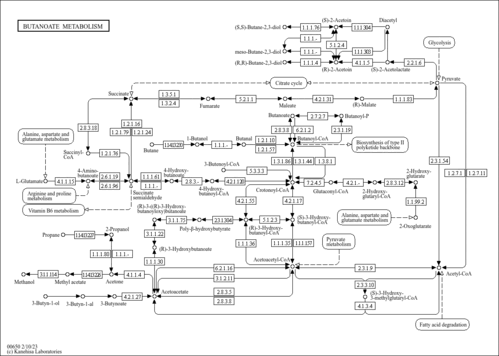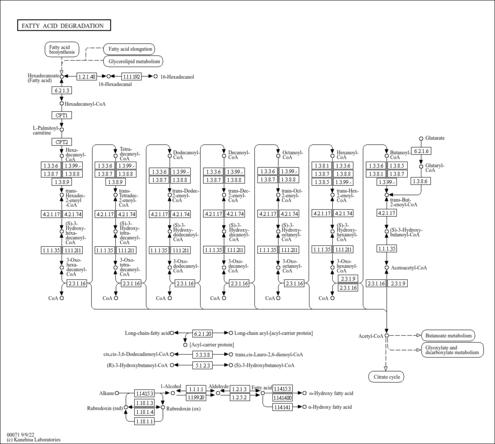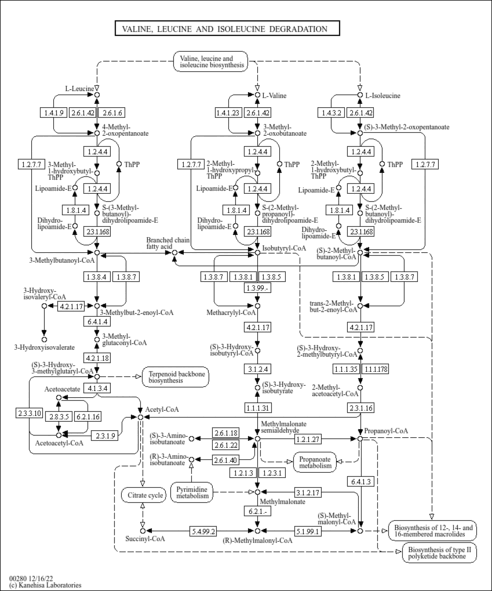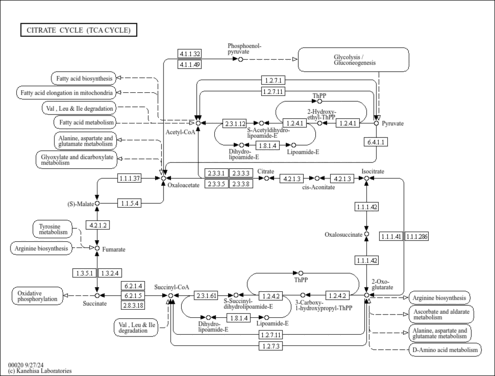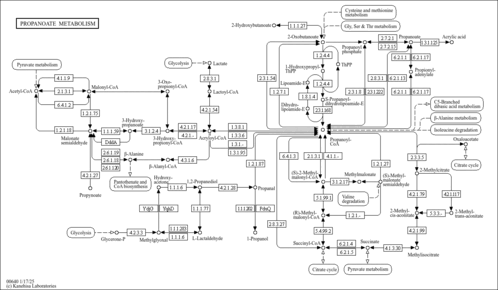| Hydroxymethylglutaryl-CoA lyase, mitochondrial | HMGCL | 1p36.1-p35 | P35914 | details |
| ATP-citrate synthase | ACLY | 17q21.2 | P53396 | details |
| Histone acetyltransferase p300 | EP300 | 22q13.2 | Q09472 | details |
| Pyruvate dehydrogenase E1 component subunit beta, mitochondrial | PDHB | 3p21.1-p14.2 | P11177 | details |
| Acetyl-CoA acetyltransferase, cytosolic | ACAT2 | 6q25.3 | Q9BWD1 | details |
| Diamine acetyltransferase 2 | SAT2 | 17p13.1 | Q96F10 | details |
| Malonyl-CoA decarboxylase, mitochondrial | MLYCD | 16q24 | O95822 | details |
| Acetyl-CoA carboxylase 2 | ACACB | 12q24.11 | O00763 | details |
| Pyruvate carboxylase, mitochondrial | PC | 11q13.4-q13.5 | P11498 | details |
| Arylamine N-acetyltransferase 1 | NAT1 | 8p22 | P18440 | details |
| Arylamine N-acetyltransferase 2 | NAT2 | 8p22 | P11245 | details |
| 5-aminolevulinate synthase, nonspecific, mitochondrial | ALAS1 | 3p21.1 | P13196 | details |
| General transcription factor 3C polypeptide 4 | GTF3C4 | 9q34.13 | Q9UKN8 | details |
| Acyl-coenzyme A thioesterase 12 | ACOT12 | 5q14.1 | Q8WYK0 | details |
| Choline O-acetyltransferase | CHAT | 10q11.2 | P28329 | details |
| Nuclear receptor coactivator 3 | NCOA3 | 20q12 | Q9Y6Q9 | details |
| Histone acetyltransferase KAT2B | KAT2B | 3p24 | Q92831 | details |
| Carnitine O-acetyltransferase | CRAT | 9q34.1 | P43155 | details |
| Diamine acetyltransferase 1 | SAT1 | Xp22.1 | P21673 | details |
| Serotonin N-acetyltransferase | AANAT | 17q25 | Q16613 | details |
| 3-ketoacyl-CoA thiolase, mitochondrial | ACAA2 | 18q21.1 | P42765 | details |
| Testis-specific chromodomain protein Y 1 | CDY1 | Yq11.23 | Q9Y6F8 | details |
| Fatty acid synthase | FASN | 17q25 | P49327 | details |
| Histone acetyltransferase KAT5 | KAT5 | 11q13 | Q92993 | details |
| Acetyl-coenzyme A synthetase, cytoplasmic | ACSS2 | 20q11.22 | Q9NR19 | details |
| Acetyl-CoA acetyltransferase, mitochondrial | ACAT1 | 11q22.3 | P24752 | details |
| Nuclear receptor coactivator 1 | NCOA1 | 2p23 | Q15788 | details |
| Hydroxymethylglutaryl-CoA synthase, mitochondrial | HMGCS2 | 1p13-p12 | P54868 | details |
| Acetyl-coenzyme A synthetase 2-like, mitochondrial | ACSS1 | 20p11.23-p11.21 | Q9NUB1 | details |
| Citrate synthase, mitochondrial | CS | 12q13.2 | O75390 | details |
| Testis-specific chromodomain protein Y 2 | CDY2A | Yq11.221 | Q9Y6F7 | details |
| 3-ketoacyl-CoA thiolase, peroxisomal | ACAA1 | 3p22.2 | P09110 | details |
| Pyruvate dehydrogenase E1 component subunit alpha, somatic form, mitochondrial | PDHA1 | Xp22.1 | P08559 | details |
| Acetyl-CoA carboxylase 1 | ACACA | 17q21 | Q13085 | details |
| Trifunctional enzyme subunit beta, mitochondrial | HADHB | 2p23 | P55084 | details |
| 2-amino-3-ketobutyrate coenzyme A ligase, mitochondrial | GCAT | 22q13.1 | O75600 | details |
| Pyruvate dehydrogenase E1 component subunit alpha, testis-specific form, mitochondrial | PDHA2 | 4q22-q23 | P29803 | details |
| Methylmalonate-semialdehyde dehydrogenase [acylating], mitochondrial | ALDH6A1 | 14q24.3 | Q02252 | details |
| Glucosamine 6-phosphate N-acetyltransferase | GNPNAT1 | 14q22.1 | Q96EK6 | details |
| Hydroxymethylglutaryl-CoA synthase, cytoplasmic | HMGCS1 | 5p14-p13 | Q01581 | details |
| Dihydrolipoyl dehydrogenase, mitochondrial | DLD | 7q31-q32 | P09622 | details |
| Dihydrolipoyllysine-residue acetyltransferase component of pyruvate dehydrogenase complex, mitochondrial | DLAT | 11q23.1 | P10515 | details |
| Long-chain specific acyl-CoA dehydrogenase, mitochondrial | ACADL | 2q34 | P28330 | details |
| Short-chain specific acyl-CoA dehydrogenase, mitochondrial | ACADS | 12q24.31 | P16219 | details |
| Medium-chain specific acyl-CoA dehydrogenase, mitochondrial | ACADM | 1p31 | P11310 | details |
| Peroxisomal acyl-coenzyme A oxidase 1 | ACOX1 | 17q25.1 | Q15067 | details |
| Peroxisomal acyl-coenzyme A oxidase 2 | ACOX2 | 3p14.3 | Q99424 | details |
| Isovaleryl-CoA dehydrogenase, mitochondrial | IVD | 15q14-q15 | P26440 | details |
| Peroxisomal acyl-coenzyme A oxidase 3 | ACOX3 | 4p15.3 | O15254 | details |
| Glutaryl-CoA dehydrogenase, mitochondrial | GCDH | 19p13.2 | Q92947 | details |
| Hepatic triacylglycerol lipase | LIPC | 15q21-q23 | P11150 | details |
| Diacylglycerol O-acyltransferase 1 | DGAT1 | 8q24.3 | O75907 | details |
| 2-oxoisovalerate dehydrogenase subunit beta, mitochondrial | BCKDHB | 6q14.1 | P21953 | details |
| 2-oxoisovalerate dehydrogenase subunit alpha, mitochondrial | BCKDHA | 19q13.1-q13.2 | P12694 | details |
| Acyl-CoA desaturase | SCD | 10q24.31 | O00767 | details |
| Sterol O-acyltransferase 2 | SOAT2 | 12q13.13 | O75908 | details |
| Sterol O-acyltransferase 1 | SOAT1 | 1q25 | P35610 | details |
| N-acetylglutamate synthase, mitochondrial | NAGS | 17q21.31 | Q8N159 | details |
| Bile acid-CoA:amino acid N-acyltransferase | BAAT | 9q22.3 | Q14032 | details |
| Long-chain-fatty-acid--CoA ligase 4 | ACSL4 | Xq22.3-q23 | O60488 | details |
| Long-chain-fatty-acid--CoA ligase 1 | ACSL1 | 4q35 | P33121 | details |
| Long-chain-fatty-acid--CoA ligase 6 | ACSL6 | 5q31 | Q9UKU0 | details |
| Long-chain-fatty-acid--CoA ligase 5 | ACSL5 | 10q25.1-q25.2 | Q9ULC5 | details |
| Long-chain-fatty-acid--CoA ligase 3 | ACSL3 | 2q34-q35 | O95573 | details |
| Glycerol-3-phosphate acyltransferase 1, mitochondrial | GPAM | 10q25.2 | Q9HCL2 | details |
| Trans-2-enoyl-CoA reductase, mitochondrial | MECR | 1p35.3 | Q9BV79 | details |
| Peroxisomal trans-2-enoyl-CoA reductase | PECR | 2q35 | Q9BY49 | details |
| Cytosolic acyl coenzyme A thioester hydrolase | ACOT7 | 1p36 | O00154 | details |
| Acyl-coenzyme A thioesterase 2, mitochondrial | ACOT2 | 14q24.3 | P49753 | details |
| Acyl-coenzyme A thioesterase 4 | ACOT4 | 14q24.3 | Q8N9L9 | details |
| Acyl-coenzyme A thioesterase 8 | ACOT8 | 20q13.12 | O14734 | details |
| Dihydroxyacetone phosphate acyltransferase | GNPAT | 1q42 | O15228 | details |
| 1-acyl-sn-glycerol-3-phosphate acyltransferase gamma | AGPAT3 | 21q22.3 | Q9NRZ7 | details |
| 1-acyl-sn-glycerol-3-phosphate acyltransferase beta | AGPAT2 | 9q34.3 | O15120 | details |
| 1-acyl-sn-glycerol-3-phosphate acyltransferase alpha | AGPAT1 | 6p21.3 | Q99943 | details |
| Short/branched chain specific acyl-CoA dehydrogenase, mitochondrial | ACADSB | 10q26.13 | P45954 | details |
| Very long-chain acyl-CoA synthetase | SLC27A2 | 15q21.2 | O14975 | details |
| Peroxisome proliferator-activated receptor gamma | PPARG | 3p25 | P37231 | details |
| Peroxisome proliferator-activated receptor alpha | PPARA | 22q12-q13.1|22q13.31 | Q07869 | details |
| Peroxisome proliferator-activated receptor delta | PPARD | 6p21.2 | Q03181 | details |
| Acyl-CoA-binding protein | DBI | 2q12-q21 | P07108 | details |
| Histone acetyltransferase KAT2A | KAT2A | 17q21 | Q92830 | details |
| Fatty acid-binding protein, heart | FABP3 | 1p33-p32 | P05413 | details |
| 1-acyl-sn-glycerol-3-phosphate acyltransferase epsilon | AGPAT5 | 8p23.1 | Q9NUQ2 | details |
| Acetyl-coenzyme A transporter 1 | SLC33A1 | 3q25.31 | O00400 | details |
| Bile acyl-CoA synthetase | SLC27A5 | 19q13.43 | Q9Y2P5 | details |
| Lipoamide acyltransferase component of branched-chain alpha-keto acid dehydrogenase complex, mitochondrial | DBT | 1p31 | P11182 | details |
| 2-acylglycerol O-acyltransferase 2 | MOGAT2 | 11q13.5 | Q3SYC2 | details |
| Long-chain fatty acid transport protein 3 | SLC27A3 | 1q21.3 | Q5K4L6 | details |
| Acyl-CoA dehydrogenase family member 10 | ACAD10 | 12q24.12 | Q6JQN1 | details |
| Acyl-CoA dehydrogenase family member 11 | ACAD11 | 3q22.1 | Q709F0 | details |
| Glycerol-3-phosphate acyltransferase 4 | AGPAT6 | 8p11.21 | Q86UL3 | details |
| Acyl-coenzyme A synthetase ACSM1, mitochondrial | ACSM1 | 16p12.3 | Q08AH1 | details |
| Diacylglycerol O-acyltransferase 2 | DGAT2 | 11q13.5 | Q96PD7 | details |
| 1-acyl-sn-glycerol-3-phosphate acyltransferase delta | AGPAT4 | 6q26 | Q9NRZ5 | details |
| 2-acylglycerol O-acyltransferase 1 | MOGAT1 | 2q36.1 | Q96PD6 | details |
| 3-hydroxymethyl-3-methylglutaryl-CoA lyase, cytoplasmic | HMGCLL1 | 6p12.1 | Q8TB92 | details |
| Isobutyryl-CoA dehydrogenase, mitochondrial | ACAD8 | 11q25 | Q9UKU7 | details |
| Acyl-CoA dehydrogenase family member 9, mitochondrial | ACAD9 | 3q21.3 | Q9H845 | details |
| Long-chain fatty acid transport protein 4 | SLC27A4 | 9q34.11 | Q6P1M0 | details |
| Fatty acyl-CoA reductase 1 | FAR1 | 11p15.2 | Q8WVX9 | details |
| Fatty acyl-CoA reductase 2 | FAR2 | 12p11.22 | Q96K12 | details |
| Acyl-CoA wax alcohol acyltransferase 1 | AWAT1 | Xq13.1 | Q58HT5 | details |
| Acyl-CoA wax alcohol acyltransferase 2 | AWAT2 | Xq13.1 | Q6E213 | details |
| Diacylglycerol O-acyltransferase 2-like protein 6 | DGAT2L6 | | Q6ZPD8 | details |
| Putative diacylglycerol O-acyltransferase 2-like protein 7 | DGAT2L7 | 7q22.1 | Q6IED9 | details |
| 2-acylglycerol O-acyltransferase 3 | MOGAT3 | 7q22.1 | Q86VF5 | details |
| Lysophospholipid acyltransferase 5 | LPCAT3 | 12p13 | Q6P1A2 | details |
| Lysophosphatidylcholine acyltransferase 1 | LPCAT1 | 5p15.33 | Q8NF37 | details |
| Lysophosphatidylcholine acyltransferase 2 | LPCAT2 | 16q12.2 | Q7L5N7 | details |
| Lysocardiolipin acyltransferase 1 | LCLAT1 | 2p23.1 | Q6UWP7 | details |
| Lysophospholipid acyltransferase LPCAT4 | LPCAT4 | 15q14 | Q643R3 | details |
| Glycerol-3-phosphate acyltransferase 3 | AGPAT9 | 4q21.23 | Q53EU6 | details |
| Glycine N-acyltransferase | GLYAT | 11q12.1 | Q6IB77 | details |
| Glycine N-acyltransferase-like protein 1 | GLYATL1 | 11q12.1 | Q969I3 | details |
| Glycine N-acyltransferase-like protein 2 | GLYATL2 | 11q12.1 | Q8WU03 | details |
| Dihydrolipoamide S-acetyltransferase | DLAT | 11q23.1 | Q86YI5 | details |
| Enoyl-CoA delta isomerase 2, mitochondrial | ECI2 | 6p24.3 | O75521 | details |
| Acyl-CoA synthetase family member 4 | AASDH | 4q12 | Q4L235 | details |
| ACSS2 protein | ACSS2 | 20q11.22 | Q96FY7 | details |
| Very long-chain specific acyl-CoA dehydrogenase, mitochondrial | ACADVL | 17p13.1 | P49748 | details |
| Acyl-coenzyme A oxidase-like protein | ACOXL | 2q13 | Q9NUZ1 | details |
| Acyl-coenzyme A synthetase ACSM6, mitochondrial | ACSM6 | 10q23.33 | Q6P461 | details |
| Acyl-coenzyme A synthetase ACSM2A, mitochondrial | ACSM2A | 16p12.3 | Q08AH3 | details |
| Acyl-coenzyme A synthetase ACSM2B, mitochondrial | ACSM2B | 16p12.3 | Q68CK6 | details |
| Acyl-coenzyme A synthetase ACSM3, mitochondrial | ACSM3 | 16p13.11 | Q53FZ2 | details |
| Acyl-coenzyme A synthetase ACSM5, mitochondrial | ACSM5 | 16p12.3 | Q6NUN0 | details |
| Peroxisomal coenzyme A diphosphatase NUDT7 | NUDT7 | 16q23.1 | P0C024 | details |
| Acyl-coenzyme A synthetase ACSM4, mitochondrial | ACSM4 | 12p13.31 | P0C7M7 | details |
| 3-oxoacyl-[acyl-carrier-protein] synthase, mitochondrial | OXSM | 3p24.2 | Q9NWU1 | details |
| Histone acetyltransferase KAT6B | KAT6B | 10q22.2 | Q8WYB5 | details |
| MYST3 protein | MYST3 | 8p11 | A5PKX7 | details |
| Histone acetyltransferase KAT8 | KAT8 | 16p11.2 | Q9H7Z6 | details |
| Histone acetyltransferase type B catalytic subunit | HAT1 | 2q31.2-q33.1 | O14929 | details |
| Glycerol-3-phosphate acyltransferase 2, mitochondrial | GPAT2 | 2q11.1 | Q6NUI2 | details |
| Chromodomain Y-like protein | CDYL | 6p25.1 | Q9Y232 | details |
| Peroxisomal D3,D2-enoyl-CoA isomerase isoform 1 variant | | | Q53GC8 | details |
| Nef-associated protein 1 | C9orf156 | 9q22.33 | Q9BU70 | details |
| Acyl-coenzyme A thioesterase 9, mitochondrial | ACOT9 | | Q9Y305 | details |
| Acyl-CoA synthetase family member 3, mitochondrial | ACSF3 | 16q24.3 | Q4G176 | details |
| Acyl-coenzyme A thioesterase 1 | ACOT1 | 14q24.3 | Q86TX2 | details |
| Cytosolic acyl coenzyme A thioester hydrolase-like | ACOT7L | | Q6ZUV0 | details |
| Acyl-CoA synthetase family member 2, mitochondrial | ACSF2 | 17q21.33 | Q96CM8 | details |
| Acyl-coenzyme A thioesterase 11 | ACOT11 | 1p32.3 | Q8WXI4 | details |
| Long-chain-fatty-acid--CoA ligase ACSBG2 | ACSBG2 | 19p13.3 | Q5FVE4 | details |
| Long-chain-fatty-acid--CoA ligase ACSBG1 | ACSBG1 | 15q23-q24 | Q96GR2 | details |
| Circadian locomoter output cycles protein kaput | CLOCK | 4q12 | O15516 | details |
| Histone acetyltransferase KAT7 | KAT7 | 17q21.32 | O95251 | details |
| Acyl-CoA synthetase short-chain family member 3, mitochondrial | ACSS3 | 12q21.31 | Q9H6R3 | details |
| Alpha-tubulin N-acetyltransferase | ATAT1 | 6p21.33 | Q5SQI0 | details |
| Heparan-alpha-glucosaminide N-acetyltransferase | HGSNAT | 8p11.1 | Q68CP4 | details |
| Histone acetyltransferase KAT6A | KAT6A | 8p11 | Q92794 | details |
| N-alpha-acetyltransferase 10 | NAA10 | Xq28 | P41227 | details |
| N-alpha-acetyltransferase 11 | NAA11 | 4q21.21 | Q9BSU3 | details |
| N-alpha-acetyltransferase 20 | NAA20 | 20p11.23 | P61599 | details |
| N-alpha-acetyltransferase 30 | NAA30 | 14q22.3 | Q147X3 | details |
| N-alpha-acetyltransferase 60 | NAA60 | 16p13.3 | Q9H7X0 | details |
| N-acetylaspartate synthetase | NAT8L | 4p16.3 | Q8N9F0 | details |
